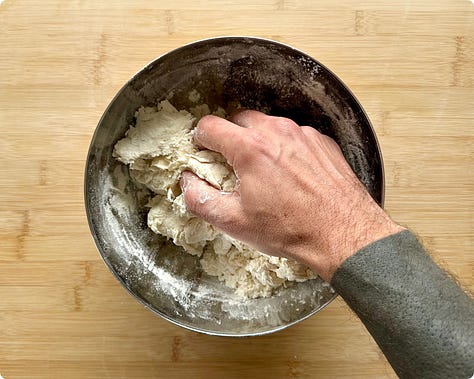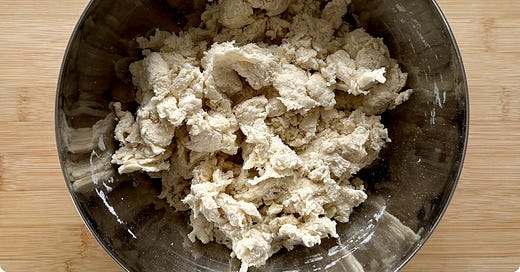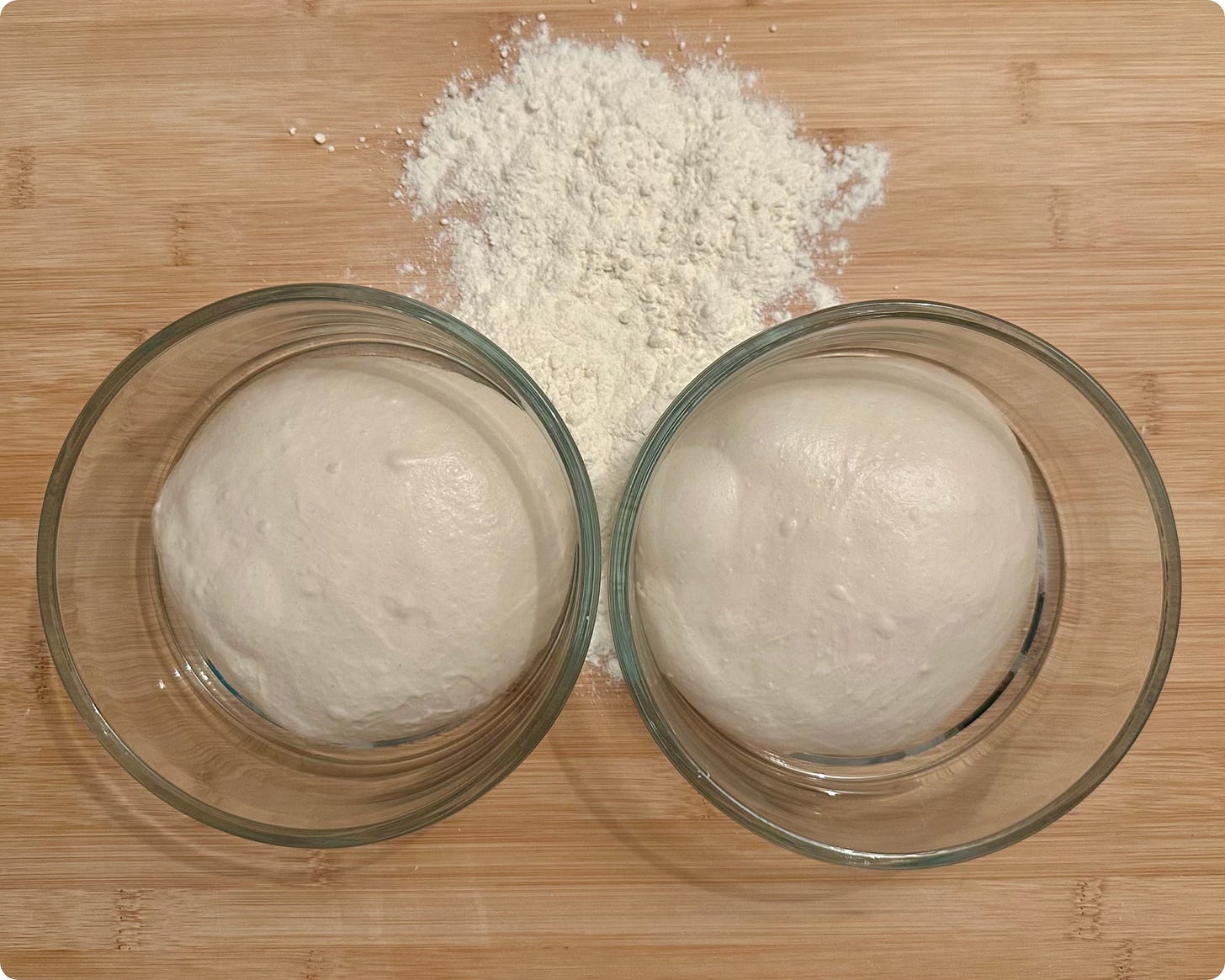Welcome to Behind The Crust - Good to have you here..!
Today, it’s all about the wild and wacky world of biga, the secret sauce (or, should I say, dough) that'll make your pizza so good you'll want to slap your nonna!
Just kidding..🤭 Keep your hands to yourself, capisce? 🫵🏻
What the Hell is Biga?
Biga is the Italian answer to the question, "How can we make pizza even more delicious?" It's a pre-ferment, basically a fancy way of saying "dough before the dough," made with flour, water, and just a smidge of yeast.
Think of it as the dough equivalent of pre-gaming before hitting the club. 🥂🪩💃
This stiff, low-hydration mixture ferments at room temperature for about 16 hours. During this time, it works its magic, developing flavors that will make your taste buds dance the tarantella.
Why Bother with Biga?
Now, you might be thinking, "Why go through all this trouble? Can't I just slap some sauce on a store-bought pizza dough and call it a day?"
Here's why biga is worth the extra effort:
Flavor: The long fermentation process develops complex, nuanced flavors that'll make your pizza taste like it was blessed by the ghost of Julius Caesar himself.
Texture: Biga contributes to a more extensible dough, making it easier to stretch out without tearing. You'll get a chewier, yet tender crust that can hold up to even the most ambitious toppings.
Digestibility: The extended fermentation breaks down some of the complex carbohydrates, potentially making the pizza easier on your gut - it's practically a superfood! 😅
Strength: Biga strengthens your dough, which is particularly useful for high-hydration doughs like those used in modern Neapolitan or Canotto-style pizzas.
Biga Percentage
Biga percentage refers to the amount of pre-fermented flour used in the final dough, expressed as a percentage of the total flour weight. Here are some key points regarding biga percentages:
Typical Range: Biga is often used in proportions between 30% and 50% of the total flour weight in the recipe. For example, if you're using 1 kg of flour in total, you might use 300g to 500g of flour to prepare the biga.
100% Biga: Some recipes utilize a "100% Biga" method, which means all of the flour in the final recipe is first used to make the biga before being combined with other ingredients for the final dough.
Fermentation Time: The percentage used can depend on fermentation time; for short ferments (12-16 hours), using 30-50% is common, while for longer ferments (36-48 hours), around 20-25% is suggested.
Experimentation: Pizza makers are encouraged to experiment with different percentages to find what works best for their specific recipes and desired outcomes. I personally get the best results with a 100% Biga dough.
Alright, let's get down to business… 💪🏻
Biga Dough Recipe
Here’s what you’ll need to make enough dough for 4 medium pizzas:
Ingredients
For the Biga:
660 g grams of flour (preferably 00 pizza flour)
220 ml of room temperature water
1 gram of dry yeast
For the final dough:
180ml room temperature water
20 grams of salt
How to Whip Up the Biga
Ready to join the biga league? Here's how to make it happen:
Step 1: Prepare the Biga
In a bowl, combine flour, water, and yeast. Mix until you achieve a rough consistency. Use your hands to squish the dough until no dry flour remains in the bowl.
Cover and let it sit at room temperature for about 16 hours.





Step 2: Make the Final Dough
In a mixing bowl, add all of the prepared biga. Mix the water and salt, gradually adding it one tablespoon at a time. After each tablespoon, knead the dough thoroughly to ensure that the water is fully absorbed before adding the next. This prevents the dough from becoming too sticky.
Knead the dough by hand or with a mixer until smooth and elastic.
Cover the dough with plastic wrap or a damp towel and let it rest at room temperature for about 30 minutes.



Step 3: Stretch and Fold
After letting the dough rest for about 30 minutes, it's time for some stretch and fold action.💪🏻
Wet your hands to prevent sticking.
Grab one side of the dough, stretch it upwards, and fold it over to the center.
Rotate the bowl 90 degrees and repeat this process until you’ve stretched and folded all four sides of the dough.
Cover the bowl again and let it rest for another 30 minutes.
Repeat this stretch and fold process two more times (for a total of three sets), allowing the dough to rest for 30 minutes between each set.
You will be rewarded with a dough that’s tighter than your jeans after Christmas dinner.
Step 4: Final Rest
After completing the stretch and fold process, cover the dough and let it rest at room temperature for about 1-2 hours or until it has doubled in size.
Step 5: Divide and Shape
After resting, gently divide the dough into 4 equal pieces (approximately 270 grams each).
Shape each piece into a tight ball.
Place the dough balls on a floured surface or in a container, cover, and let them rise for another hour or until doubled at room temperature.
Final Slice
Using biga in your pizza dough is like upgrading from a bicycle to a Ferrari. Sure, it takes a bit more effort, but the results are worth it.
Check out this crust.. 🤯
Your pizza will have a depth of flavor and a texture that'll make your local pizzeria weep with envy.
By using biga, you're not just making pizza - you're participating in a centuries-old Italian tradition. You're creating a crust with complex flavors, a perfect chew, and a structure that can stand up to whatever toppings your heart desires.
Plus, you get to feel like a mad scientist in the process. Win-win! ⚗️🧪🥼 So go forth and embrace the biga life. 😁
Your taste buds (and your dinner guests) will thank you. Just remember, with great pizza comes great responsibility - mainly the responsibility to share. Or not.
I won't judge. After all, a pizza this good might be too precious to part with.
Now get that oven on and bake something tasty!
Stay cheesy,
Filippo
🍕What other topics are you interested in? Drop me a line to let me know!








